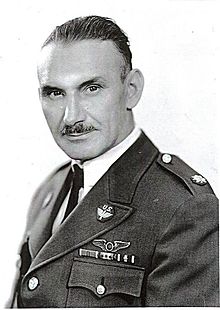Albert William Stevens | |
|---|---|
 | |
| Born | March 13, 1886 Belfast, Maine, U.S. |
| Died | March 26, 1949 (aged 63) Redwood City, California, U.S. |
| Allegiance | |
| Branch | Army Air Corps |
| Rank | Captain |
| Commands held | Explorer II |
| Wars | World War II |
| Awards |
|
Albert William Stevens (March 13, 1886 – March 26, 1949) was an officer of the United States Army Air Corps, balloonist, and aerial photographer.
Biography[edit]
He was born on March 13, 1886, in Belfast, Maine. He graduated from the University of Maine in 1909 with a master's degree in electrical engineering.
While flying over South America in 1930, Stevens took the first photograph of the Earth in a way that the horizon's curvature is visible.[1] To photograph through haze, Stevens often employed infrared-sensitive film for long-distance aerial photography.[2]
Accompanied by Lieutenant Charles D. McAllister of the Army Air Corps, Stevens took the first photograph of the Moon's shadow projected onto the Earth during a solar eclipse in August, 1932.[3]
On July 29, 1934, Stevens and two other Army Air Corps officers, Major William Kepner and Captain Orvil Arson Anderson, ascended in a specially-constructed balloon and gondola named Explorer I over north-western Nebraska in an attempt to exceed the current altitude record for manned flight. However, nearing the current record height, the balloon envelope ruptured, sending the gondola plunging to earth.[4] Fortunately, all three crew were able to eventually exit and parachute to earth before the gondola crashed into a farm field.[5]
On November 11, 1935, Stevens, along with Captain Anderson, made a record balloon ascent from the "Stratobowl" (a natural depression) near Rapid City, South Dakota.[6] There were 20,000 spectators, while millions of people listened to a live NBC radio broadcast.[7] Their sealed gondola Explorer II floated to 72,395 feet (22,066 m), nearly 14 miles (23 km), a world altitude record unequaled until 1946 and a balloon record unequaled until 1956.[8][9][10][11]
Stevens was twice awarded the Distinguished Flying Cross – one award for each of his two famous balloon flights.
He died on March 26, 1949, in Redwood City, California.
See also[edit]
References[edit]
- ^ Laurence, William L. (December 31, 1930). "Earth's Curve Seen in Photo from Plane; Picture Shown to Scientists Has Rounding of Horizon 300 Miles Away". The New York Times. p. 1.
- ^ "Aerial picture of mountain two hundred miles away". Popular Mechanics. 53 (1): 96. January 1930 – via Google Books.
- ^ "Stevens Photographs Eclipse 5 Miles In Air. Army Expert Says That Corona Sprang Into Sight as if Switch Was Snapped". The New York Times. September 1, 1932. p. 10. Retrieved December 30, 2009.
Flying at an altitude of five miles near the centre line of the eclipse zone, the aerial unit of the National Geographic Society's eclipse expedition, conducted by Captain Albert W. Stevens and Lieutenant Charles D. McAllister of the Army Air Corps, had an unobstructed view of the eclipse throughout totality. ...
- ^ "Space Men: They were the first to brave the unknown - Transcript". American Experience. PBS. March 1, 2016. Retrieved January 2, 2019.
- ^ "Pictures Tell Story Of Americans' Stratosphere Flight". Popular Science. 125 (1): 23. October 1934 – via Google Books.
- ^ "Gondola Steamed 73,000 Feet In Air. Captains Stevens and Anderson, Arriving in Chicago, Say They Were Mystified. Stratosphere Balloonists, With Capt. Williams, Ground Officer, Will Reach Capital Today". The New York Times. November 13, 1935. Retrieved May 26, 2011.
Captain Orvil A. Anderson and Captain Albert W. Stevens declared here today that they are willing to take another trip into the stratosphere at any time, and are confident that on the next endeavor they will surpass their record fourteen-mile ascent.
- ^ Lee Wells Jr. (1935). "First High-Altitude Photo". National Geographic. Archived from the original on January 18, 2010.
- ^ "Space Men: Transcript". American Experience. PBS. July 9, 2019. Retrieved September 11, 2019.
- ^ "Honored On Flight Into Stratosphere. Captains Stevens and Anderson Receive Hubbard Medal of Geographic Society. Notable Assembly in Washington Sees Photos Made 13 Miles Above the Earth". The New York Times. December 12, 1935. p. 29. Retrieved December 30, 2009.
The Hubbard Gold Medal of the National Geographic Society was presented by General Pershing tonight to Captain Albert W. Stevens and Captain Orvil A. Anderson of the Army Air Corps, in recognition of their ascent into the stratosphere on Nov. 11, when they reached an official altitude of 72,395 feet. ...
- ^ Record Balloon Flights - The Race to the Stratosphere Archived 2006-03-09 at the Wayback Machine
- ^ Goliath, The first space race? The Explorer II balloon flight of 1935. Sep 22, 2006.
External links[edit]
- The Explorer I crew - Major William Kepner, Captain Albert Stevens, and Captain Orvil Anderson, on July 28, 1934
 Media related to Albert William Stevens at Wikimedia Commons
Media related to Albert William Stevens at Wikimedia Commons